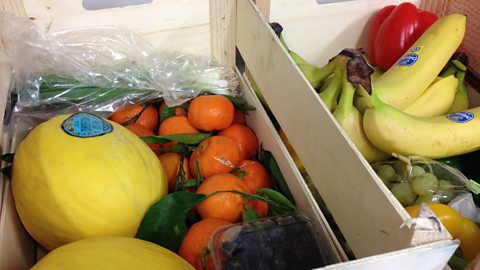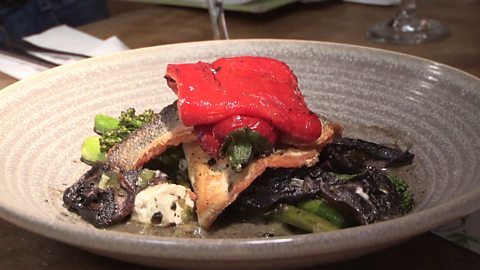Offering ideas and suggestions
Watch the video to find out more.
Speaker 1: A bit of custard, little bit of cake, that would be good, thank you very much.
Thank you. You're doing well, son. Well done. Thank you.
Speaker 2: All right, guys. I've called this meeting today because the manager's had a word with me regarding the kind of nutritional value regarding desserts too much sugar, too much fats in 'em.
Er, What's happening is obviously we've got the sticky toffee pudding today, so I want your ideas to tell me how to make this healthy, really, or, you know, another solution.
Down to you guys, really. What do you think?
Speaker 3 We can introduce some fruit in it.
Speaker 2: Yeah, that sounds good.
Speaker 4: Raspberry, a fruit… You talked about adding fruit, so we can just make a coulis to go with it.
Speaker 2: Would that be the same flavours, though?
Cos let's be honest, we'd be getting rid of a nice sweet pudding for something really sour and sharp.
Speaker 4: Yeah.
Speaker 5: I would change it completely.
Speaker 2: To what?
Speaker 5: Er… a pie?
Speaker 4: I agree with Donna.
You can't adapt a sticky toffee pudding.
So if we're talking about adapting the pudding, I think we should just take it off the menu completely.
Speaker 2: The first thing that comes to my mind is some kind of honey fruitcake.
Speaker 3: We could have a sponge still…
Have our sponge, but make it a little bit healthier.
Speaker 2: What's in season at the moment, I would say, is pears.
Speaker 4: Pears.
Speaker 2: Yeah? So, like, a pear kind of honey kind of cake?
How does that sound for the moment?
Speaker 4: Yeah, that sounds nice.
Speaker 5: Give it a go.
Speaker 2: OK. We'll road-test it and come back and have a meeting about it.
Speaker 4: OK.
Speaker 2: Yeah? OK. Cheers.
Which statements show respect?
Test your knowledge with this activity.
How to write clear instructions
Watch the video to find out more.
Speaker 1: (TO AUDIENCE) In any kind of instructions, they've got to be clear.
You can't make 'em too long, either.
We like to create a template, which obviously has a picture, first of all, because a visual aid is quite handy, but as well as that, the ingredients list and the methodology of how it's done.
So that template is something that we follow with every single recipe.
Speaker 2: (TO OTHER PEOPLE) So what do you reckon? Are you going to start with…?
Speaker 1: (TO AUDIENCE) Sometimes you type it out how you think in your head, but when you read it out again to yourself, you think, well, actually, does that make sense?
Speaker 2: (TO OTHER PEOPLE) Beat the butter and sugar together until very light and flurry. 'Flurry'?
Speaker 1: I think that's supposed to say 'fluffy', yeah.
Speaker 2: You sure about that?
'Beat in the eggs, one at a time.'
'Spread this cake mixture in the prepared tin and arrange the pears on top.'
'Bake for about 45 minutes.'
Speaker 1: (TO AUDIENCE) You've got to be precise, it's got to be clear, and if you keep it nice and simple then people can follow it.
And then that way, you can't go wrong.
Speaker 1: (TO OTHER PEOPLE) Right, guys, tuck in, yeah? Honest opinions.
Speaker 3: Tastes quite nice. I'm quite surprised!
Speaker 1: What kind of things would you serve it with?
Speaker 3: Can add crème fraîche, to go with it?
Speaker 2: Would they like crème fraîche, though?
Speaker 1: These kids here? Nah, mate.
Not in a million years, yeah? Low-fat custard?
Speaker 3: That would go down well as well.
Speaker 1: Kids like a bit of sauce on there, don't they?
Speaker 3: Yeah.
Speaker 1: Well done, guys. That's all perfect.
We're going to roll it out on the menu. Fantastic.
Rewrite the instructions
Test your knowledge with this activity.
More on Catering
Find out more by working through a topic
- count2 of 5

- count3 of 5
